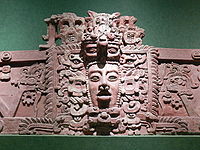- Maya textiles
-

Maya civilization People · Languages · Society Religion · Mythology · Sacrifice Cities · Architecture · Calendar Stelae · Textiles · Trade Pre-Columbian Music · Writing History Preclassic Maya Classic Maya collapse Spanish conquest of Yucatán Spanish conquest of Guatemala Knowledge of pre-Hispanic Mayan textiles is limited mostly to elite costumes.
Contents
Huipil
The most prevalent and influential aspect of women’s clothing in ancient Maya is the huipil, which is still prominent in Guatemalan and Mexican culture today. The huipil is a loose rectangular garment with a hole in the middle for the head made from lightweight sheer cotton. The huipil is usually white with colorful cross-stripping and zigzag designs woven into the cloth using the brocade technique still commonly used today. The huipil could be worn loose or tucked into a skirt; this depends on the varying lengths of the huipil. Huipils were important displaying one’s religion and tribal affiliation. Different communities tended to have different designs, colors, lengths as well as particular huipils for ceremonial purposes. It was uncommon and often disgraceful to wear a huipil design from another community within one’s village; although, it was a sign of respect to wear a community’s huipil when visiting another village. Although, women were not just limited to their community’s design. Instead the design offered an outline for what women were required to have and within the community design women were allowed creativity to make theirs different from others often to express praise to different kiuggkes animals around the collar.
Technicalities
Besides other duties one of the top priorities for women was the weaving of cotton cloth for their family because textiles were a significant form of art and religious beliefs. In ancient Maya women had two natural types of cotton to work with, one white and the other light brown, both of which were commonly dyed. The preparation of cotton for spinning was very burdensome, as it had to be washed and picked clean of seeds. Mayan women wove in patterns on a backstrap loom with spindle fibers and bone picks. Bone picks were unique in that they had different designs for most families and were usually passed on from generation to generation with the elite having the most expensive and beautiful. Elite women were also given the opportunity to work with the most expensive dyes, feathers, and pearl beads. However, women of the elite not only had to prepare the best clothing for their families they also had to be talented in weaving tapestry, brocade, embroidery, and tie-dyeing for tribute to other families and rulers. Weavers had three different natural dyes to work with, indigo which supplied different shades of blue. Cochineal, an insect that when crushed and dried makes the color red, and a coastal mollusk which they used to whiten cloth by extracting fluid from its glands. Women also worked with maguey, which is a variety of fibers taken from an agaves plant. Maguey was of major value as a cordage material used for horse gear, nets, hammocks, and bags.
Ideological aspects
The Maya believed that clothing could transform a person and a person could transform the garment and is expressed through it, so naturally clothing was of great cultural significance. They would often make textiles to enhance religious power; the most common way of doing this was dressing for the maize gods. Women and men would wear a net overskirt made of jade, the color of life, which represented their high place in society. In order to dress as a maize deity and manipulate the regeneration of the maize plant they would weave serpents onto huipils to symbolize lightning. The lightning god is the god believed to have created maize on the top of Mt. Sustenance. Mayan elite would also wear a shark shell belt and a jade-netted collar to the maize deity costume. Other significant costumes consisted of wearing many quetzal and eagle feathers on headdresses to represent and elite’s power in blue and green tones, which represented the fifth direction, the center of celestial, terrestrial and the underworld levels of the cosmos. Kings would also wear jaguar skin skirts, which signified their connection between the sky and the earth.
See also
References
- Martin, Simon et al. (2004) Courtly Art of the Ancient Maya, London: Thames and Hudson, p16-198.
- O'Neale, Lila M. (1945) Textile of Highland Guatemala. Washington D.C.: Carnegie Institution of Washington, p7-27.
- Schevill, Margot B. (1993) Maya Textiles of Guatemala (1st ed.) Austin: University of Texas Press, p8-60.
Textile arts Fundamentals Applique · Beadwork · Crochet · Dyeing · Embroidery · Fabric (textiles) · Felting · Fiber · Knitting · Lace · Macramé · Nålebinding · Needlework · Patchwork · Passementerie · Plying · Quilting · Rope · Rug making · Sewing · Stitch · Spinning · Spinning by hand · Sprang · Tapestry · Tatting · Textile printing · Weaving · YarnHistory of ... Regional and ethnic Related Blocking · Fiber art · Mathematics and fiber arts · Manufacturing · Preservation · Recycling · Textile industry · Textile Museums · Units of measurement · Wearable fiber artReference Categories:- Maya science and technology
- Maya clothing
- Maya art
- Indigenous textile art of the Americas
- Textile arts of Central America
- Textile arts of Mexico
Wikimedia Foundation. 2010.

